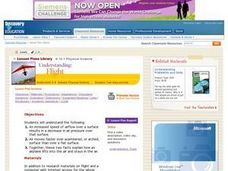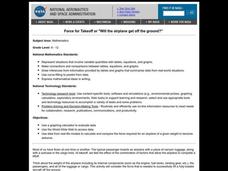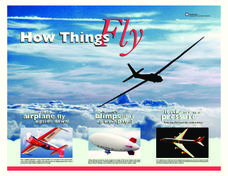Curated OER
Principles of Flight: Bernoulli's Lift
Students discover how air pressure effects flight. In this physics lesson, students create two types of airplane wings so they can observe the way air pressure creates lift. Students utilize a printout to create the airplane...
Curated OER
Lift and Launch Angle
Students engage in a hands-on experiment to determine how launch angles affect airflow around the wing of an aircraft. They view a series of photographs and read information describing the Wright Brothers' experiences. They complete a...
Curated OER
Understanding: Flight
Students review the principles of flight before performing a series of simple experiments. Working in small groups, they complete hands-on activities that demonstrate the principles that make it possible for an airplane to lift into air...
Curated OER
Math: Will The Airplane Get Off the Ground?
Students use data from real-life models to calculate and compare the force required for an airplane of a given weight to become airborne. They use a graphing calculator to evaluate data and use the World Wide Web to access data.
Curated OER
Wing Area Effects Problem Set
Young scholars read an explanation from a NASA Web-based textbook on lift and an explanation on the FoilSim software package given below. They use FoilSim to evaluate the relationship between wing area and lift.
Curated OER
Using 3-D Models for Code Validation with FoilSim
Students use FoilSim to complete the activity to create tables of data sets comparing the lift values for a 3-D model of a symmetrical wing section to the values predicted by the FoilSim software.
Curated OER
Testing and Refining Aircraft Design
High schoolers design and make a flying device. They work in small groups to brainstorm ideas for the design of their device. They choose an idea or combination of ideas to use for their design and create a sketch of their design. The...
Curated OER
How Things Fly
Young scholars explain basic principles of aeronautics such as gravity and lift. In this How Things Fly lesson, students visit the interactive, hands-on How Things Fly gallery at the Smithsonian. Young scholars perform three experiments...
Curated OER
An Uplifting Experience
Students examine the forces that affect the flight of airplanes through the use of paper airplanes. They conduct Internet research, conduct experiments demonstrating Bernoulli's Principle, and design and construct a paper airplane.
Curated OER
Flying With The Wright Stuff
Young scholars explore the history of flight, specifically the Wright brothers. Pupils create paper airplanes. They discuss considerations in building an aircraft such as drag, thrust, and weight. Classmates compare the Wright...
Curated OER
John J. Montgomery: Controlling flight
Students research the history of aviation while looking at how gliders and airplanes fly. This lesson is the perfect way to intertwine Science and History. It has variations for all grade levels K-12.
Curated OER
Airplanes
Students practice multiplication using factors to 5. They discuss the wings of birds and the wings of airplanes and complete activity sheet. Afterwards, they number and draw groups of airplanes.
Curated OER
Size Effects Problem Set
Learners, after reading the Size Effects page from a NASA Web-based textbook, demonstrate an understanding of Size Effects by answering questions.
Curated OER
Aeronautics: Bernoulli's Principle
Learners explore physics by participating in a science activity in class. In this flight properties lesson, students identify Bernoulli's principle of flight and his theory of statics and motion. Learners conduct a demonstration by...
Curated OER
Actual Airflow vs. Ideal Airflow: Stalls
Students use 3-D modeling techniques to observe the characteristic signature of the stall condition apparent on an airfoil at high angles of attack. They use FoilSim to compare the above with ideal airflow.
Curated OER
Olympic Training Center
Students decide on an activity like running, swimming or skating for a performance analysis. They have friends or family members videotape them as they exercise, then review the video to see how they can improve their performance.

















